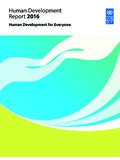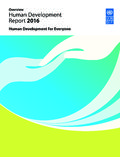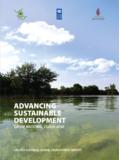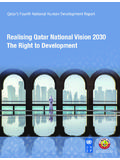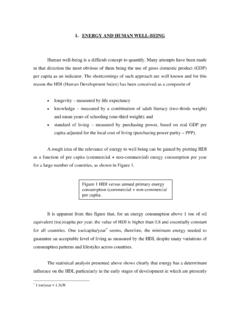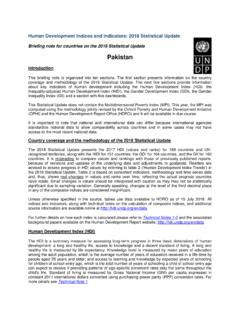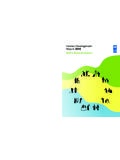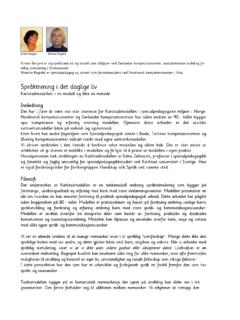Transcription of Statistical annex - Human Development
1 Human Development REPORT 2015. Work for Human Development Statistical annex Readers guide 203. Statistical tables Human Development indices 1 Human Development Index and its components 208. 2 Human Development Index trends, 1990 2014 212. 3 Inequality-adjusted Human Development Index 216. 4 Gender Development Index 220. 5 Gender Inequality Index 224. 6 Multidimensional Poverty Index: developing countries 228. 7 Multidimensional Poverty Index: changes over time 230. Human Development indicators 8 Population trends 234. 9 Health outcomes 238. 10 Education achievements 242. 11 National income and composition of resources 246. 12 Environmental sustainability 250. 13 Work and employment 254.
2 14 Human security 258. 15 International integration 262. 16 Supplementary indicators: perceptions of well-being 266. Regions 270. Statistical references 271. Statistical annex | 201. Readers guide The 16 Statistical tables in this annex as well as the Statistical Methodology updates tables following chapters 2, 4 and 6 provide an overview of key aspects of Human Development . The first seven tables contain The 2015 Report retains all the composite indices from the the family of composite Human Development indices and their family of Human Development indices the HDI, the Ine- components estimated by the Human Development Report quality-adjusted Human Development Index, the Gender Office (HDRO).
3 The remaining tables present a broader set of Development Index, the Gender Inequality Index and the Mul- indicators related to Human Development . tidimensional Poverty Index. The methodology used to com- Unless otherwise specified in the notes, tables use data avail- pute these indices is the same as one used in the 2014 Report. able to the HDRO as of 15 April 2015. All indices and indica- For details see Technical notes 1 5 at tors, along with technical notes on the calculation of composite indices and additional source information, are available online at Comparisons over time and across editions Countries and territories are ranked by 2014 Human Devel- of the Report opment Index (HDI) value.
4 Robustness and reliability analysis has shown that for most countries the differences in HDI are Because national and international agencies continually not statistically significant at the fourth decimal For improve their data series, the data including the HDI values this reason countries with the same HDI value at three decimal and ranks presented in this Report are not comparable to places are listed with tied ranks. those published in earlier editions. For HDI comparability across years and countries, see table 2, which presents trends using consistent data. Sources and definitions Unless otherwise noted, the HDRO uses data from interna- Discrepancies between national and tional data agencies with the mandate, resources and expertise international estimates to collect national data on specific indicators.
5 Definitions of indicators and sources for original data com- National and international data can differ because interna- ponents are given at the end of each table, with full source tional agencies harmonize national data using a consistent details in Statistical references. methodology and occasionally produce estimates of missing data to allow comparability across countries. In other cases international agencies might not have access to the most recent Gross national income per capita in national data. When HDRO becomes aware of discrepancies, purchasing power parity terms it brings them to the attention of national and international data authorities. In comparing standards of living based on income across coun- tries, the income component of the HDI uses gross national income (GNI) per capita converted into purchasing power par- Country groupings and aggregates ity (PPP) terms to eliminate differences in national price levels.
6 The International Comparison Programme (ICP) survey is The tables present weighted aggregates for several country the world's largest Statistical initiative that produces interna- groupings. In general, an aggregate is shown only when data tionally comparable price levels, economic aggregates in real are available for at least half the countries and represent at least terms and PPP estimates. Estimates from ICP surveys conduct- two-thirds of the population in that classification. Aggregates ed in 2011 and covering 190 countries were used to compute for each classification cover only the countries for which data the 2014 HDI values. are available. Readers guide | 203.
7 Human Development classification Statistical acknowledgements HDI classifications are based on HDI fixed cut-off points, The Report's composite indices and other Statistical resources which are derived from the quartiles of distributions of com- draw on a wide variety of the most respected international ponent indicators. The cut-off points are HDI of less than data providers in their specialized fields. HDRO is particularly for low Human Development , for medium Human grateful to the Centre for Research on the Epidemiology of Dis- Development , for high Human Development and asters; Economic Commission for Latin America and the Car- or greater for very high Human Development .
8 Ibbean; Eurostat; Food and Agriculture Organization; Gallup;. ICF Macro; Internal Displacement Monitoring Centre; Inter- Regional groupings national Labour Organization; International Monetary Fund;. International Telecommunication Union; Inter-Parliamentary Regional groupings are based on United Nations Development Union; Luxembourg Income Study; Organisation for Econom- Programme regional classifications. Least Developed Countries ic Co-operation and Development ; United Nations Children's and Small Island Developing States are defined according to Fund; United Nations Conference on Trade and Development ;. UN classifications (see ). United Nations Department of Economic and Social Affairs.
9 United Nations Economic and Social Commission for West Developing countries Asia; United Nations Educational, Scientific and Cultural Organization Institute for Statistics; Office of the United Aggregates are provided for the group of countries classified as Nations High Commissioner for Refugees; United Nations developing countries. Office on Drugs and Crime; United Nations World Tourism Organization; World Bank; and World Health Organization. Organisation for Economic Co-operation and The international education database maintained by Robert Development Barro (Harvard University) and Jong-Wha Lee (Korea Univer- sity) was another invaluable source for the calculation of the Aggregates are presented for the 34 members of the Organi- Report's indices.
10 Sation of Economic Co-operation and Development , 31 of which are developed countries and 3 of which are developing countries. Aggregates refer to all countries from the group for Statistical tables which data are available. The first seven tables relate to the five composite Human devel- opment indices and their components. Country note Since the 2010 Human Development Report, four composite Human Development indices the HDI, the Inequality-ad- Data for China do not include Hong Kong Special Administra- justed Human Development Index, the Gender Inequality tive Region of China, Macao Special Administrative Region of Index and the Multidimensional Poverty Index have been China or Taiwan Province of China.
